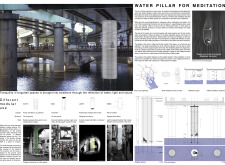5 key facts about this project
The project is located in Tokyo, a city shaped by its complex network of rivers. Amid rapid urban growth that has increasingly obscured these waterways, the design aims to bridge the gap between urban residents and their natural environment. The focus is on developing meditation cabins that provide quiet spaces, allowing individuals to reconnect with the cultural and emotional importance of water in Japanese life.
Design Concept
The overall idea centers on integrating meditation cabins into overlooked urban areas. These structures are strategically placed beneath bridges and roads, transforming neglected spots into peaceful environments that invite interaction with water. The goal is to rejuvenate these underused spaces, fostering a renewed sense of connection within the bustling city.
Architectural Form
The cabins are designed with a column-like shape that reflects the historical significance of water in the city's development. This form engages with the surrounding environment, enhancing the vertical skyline of Tokyo. The design promotes a sense of lightness and transparency, allowing natural light to flood in and creating a link between indoor and outdoor experiences.
Meditation Platform
An important feature of the design is the circular meditation platform, which includes an opening that provides views of the river below. This platform encourages reflection and relaxation, allowing users to engage directly with the water. The design creates a sensory space through the mixing of light and sound, inviting people to be present in their surroundings.
Materiality
Specific materials chosen for the project complement its design and function. Thin metal chains form a breathable shell around the cabins, evoking the movement of water and enhancing the calming atmosphere. The circular platform is built from cross-laminated timber, offering warmth and a natural feel. Steel wires ensure stability while maintaining a lightweight design that does not overpower the setting.
At its core, the project creates a connection between architecture and nature, where the gentle flow of water and the sounds of the city create a nurturing space for reflection and peace.




















































